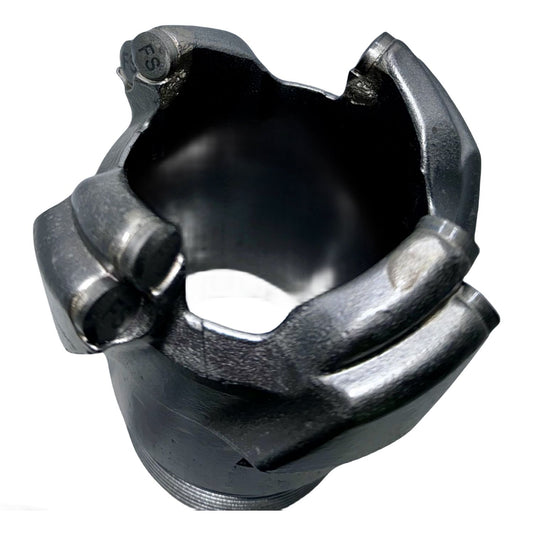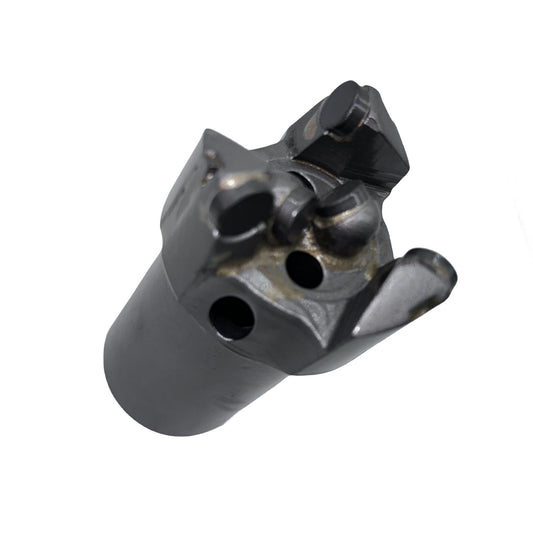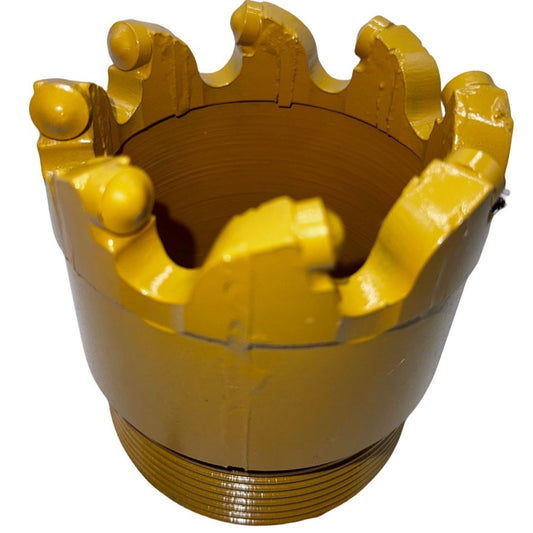Modern Drilling Technology Guide: Drill Bit Selection & Rock Adaptability
Modern Drilling Technology Manual: Drill Bit Selection and Rock Adaptability Guide
Core of Drilling Technology: Rock Hardness and Drill Bit Innovation
In this comprehensive guide, we will delve deeply into the basic concepts of rock hardness and drill bit technology, with a special focus on how Polycrystalline Diamond Compact (PDC) technology is revolutionizing modern drilling activities. We will thoroughly analyze how rock hardness affects drilling efficiency and how to choose the appropriate drill bits based on the characteristics of different rock layers to help you optimize drilling efficiency and cost-effectiveness.
Additionally, this guide includes a comprehensive overview of drill bit types, detailing the design features and applicable scenarios of each type, ensuring you can make informed decisions based on specific geological conditions. We will also discuss key drilling
parameters such as drilling speed and recommended pull-out lengths, providing you with a complete set of strategies and operational guidance for drilling.
Through this guide, you will not only master the latest drilling technologies but also learn how to effectively apply these advanced techniques in practical work. Whether you are a seasoned drilling expert or a newcomer to the field, we hope this guide will help you achieve higher efficiency and better results in your drilling projects.
Definition of Rock Hardness
Rock hardness is a critical factor in determining drilling efficiency. It depends on the hardness of the minerals that make up the rock and its structural characteristics such as crystal size, layering, and fissure distribution. For instance, rocks composed of quartz pose a greater challenge for drill bits due to their higher hardness compared to those made of calcite, which are relatively easier to penetrate. These hardness properties and the structural complexity of the rocks not only affect the mechanical behavior during drilling but also significantly impact the wear on the drill bits.

Overview of Drill Bit Technology
Understanding the impact of rock hardness on drill bit selection is crucial for enhancing drilling speed and extending the lifespan of the drill bits, both of which are vital for the economic viability of drilling projects. Therefore, the development of drill bit technology focuses on efficient designs that can effectively cut through rock while minimizing friction and debris discharge. With advances in materials science, traditional steel drill bits are being progressively replaced by those containing synthetic diamonds or other superhard materials. These are particularly suitable for medium to extremely hard rock layers, where modern drill bits demonstrate significant improvements in drilling efficiency.
PDC Technology and Its Development
Revolutionary Advances in PDC Technology
Polycrystalline Diamond Compact (PDC) drill bits represent a revolutionary advancement in drilling technology, combining multiple layers of synthetic diamond particles with a hard alloy base through a high-temperature, high-pressure sintering process. This structure not only provides the drill bit with exceptional hardness and wear resistance but also maintains the necessary toughness to perform excellently under the high impact forces encountered during drilling operations.

Expansion of PDC Technology Applications
Following breakthroughs in the drill bit arena, the initial applications of PDC technology were primarily concentrated in the high-cost sectors of oil and gas extraction. However, with advancements in production technology and increased cost-efficiency, the use of PDC drill bits has successfully expanded into broader areas such as water well drilling and coal mining. This expansion is underpinned by the ability of PDC drill bits to maintain high cutting efficiency and low operational costs across various geological environments, making them the preferred solution for both hard and soft rock drilling operations. Additionally, the durability and efficiency enhancements of PDC drill bits have brought new opportunities for sustainable development in the drilling industry, significantly reducing the overall costs of projects and propelling the modernization of drilling technology.
Hunan Fengsu Drilling Co., Ltd.'s Market Leadership
With the widespread adoption and development of Polycrystalline Diamond Compact (PDC) technology, Hunan Fengsu Drilling Co., Ltd. has significantly bolstered its competitive stance in the global drill bit market. The company has secured multiple patents related to PDC drill bit technology, which not only diversifies its product range but also caters to the specific geological challenges of its clients by providing tailor-made solutions. By continuously enhancing its manufacturing techniques, Fengsu has effectively reduced production costs while maintaining the high wear and impact resistance of its products. This approach not only decreases the frequency of drill bit replacements but also significantly reduces drilling costs for users, all while sustaining competitive prices and ensuring product quality.
This technological and market-leading edge not only underscores the transformative impact of PDC technology but also indicates the future trajectory of drill bit technology. The subsequent sections will delve deeper into various types of drill bits and their applications across different rock layers, starting with alloy drill bits. This ensures that our readers can select the most appropriate drill bits based on specific geological conditions. Furthermore, an understanding of the design features and optimal scenarios for these drill bits will aid readers in enhancing drilling efficiency, reducing costs, and ensuring operational safety.
Overview of Drill Bit Types
Common Types of Drill Bits
Alloy Drill Bits
Alloy drill bits are known for their wear resistance and cost-effectiveness, making them particularly effective in loose or softer rock layers. They are ideal for handling unconsolidated materials like soft soil and clay, which makes them perfect for initial drilling and exploration tasks.
Small-Tooth Composite Drill Bits
These drill bits feature smaller teeth, increasing the contact area with the rock and thereby enhancing drilling efficiency in variously hardened loose rock layers. This design facilitates more effective cutting in metamorphic and weathered rocks, reducing resistance.
Standard Composite Drill Bits
As versatile tools, standard composite drill bits are well-suited for a broad spectrum of rock layers, especially those ranging from soft to medium-hard. Their design optimally balances cutting efficiency with wear resistance, making them essential for drilling operations.
Specially Designed Composite Drill Bits
Triangular Composite Drill Bits
These drill bits are specifically engineered to enhance cutting power and debris removal, ideal for drilling through harder rock types like sandstone and limestone. Their triangular shape concentrates the cutting force, effectively penetrating tough layers.
Bread-Shaped Composite Drill Bits
With their unique wide, flat design, these drill bits optimize debris clearance efficiency in softer rocks. They are particularly effective in rocks containing clay or mud, allowing for rapid penetration while minimizing clogging.
Blade-Shaped Composite Drill Bits
Designed for medium-hard to hard rocks, these drill bits feature sharp cutting edges that optimize cutting power. They are effective in reducing friction and wear when drilling through materials such as granite or metamorphic rocks.
Reinforced Composite Drill Bits
These drill bits are tailored for medium-hard rock layers, enhancing wear resistance and impact strength to extend their lifespan. Suitable for harsh conditions, such as in rock layers with a high content of silicates, these drill bits are built to withstand rigorous drilling demands.
High-Performance Drill Bits
Steel-Toothed Composite Drill Bits
Designed to penetrate hard rock formations, steel-toothed composite drill bits offer robust penetration capabilities and high abrasion resistance. These drill bits are commonly used in mining and deep well drilling, especially when penetrating hard rock layers such as basalt or diabase.
Conventional Electroplated Diamond Drill Bits
Favored for their enduring cutting ability in hard rocks, conventional electroplated diamond drill bits are typically used in applications requiring high abrasion resistance and longevity, such as deep well drilling and core sampling.
Thermally Stable Polycrystalline (TSP) Diamond Drill Bits
Thermally Stable Polycrystalline (TSP) diamond drill bits are manufactured under high pressure and high temperature, suitable for drilling into very hard rocks. The manufacturing process ensures that these drill bits perform reliably under extreme conditions, making them an ideal choice for cutting through the hardest materials such as quartz and corundum rocks.
Yttria Stabilized Zirconia Sintered Drill Bits
Yttria stabilized zirconia sintered drill bits are specifically designed for drilling through extremely hard rock layers, offering maximum penetration under high loads. These drill bits are particularly suited for deep geological exploration and mineral extraction in hard rock environments.
Low-Degree Electroplated Diamond Drill Bits
Designed for developing extremely hard rock layers, low-degree electroplated diamond drill bits emphasize efficiency and penetration ability under extreme hardness conditions. These drill bits also reduce the frequency of replacements while providing high cutting efficiency.
Rock Layer Classification and Drill Bit Applications
This guide aims to assist users in selecting the most suitable drill bits based on specific geological conditions and drilling requirements. We have explored a variety of drill bit types, from alloy to high-performance bits, each designed with unique features to adapt to different rock hardness levels and specific drilling environments.
The following sections will continue to detail the practical applications and operational advice for these drill bits. We will provide practical information and strategies to ensure readers can fully utilize these advanced drilling technologies to enhance drilling efficiency, reduce costs, and ensure operational safety.
Levels 1 to 3 (Loose Soil to Soft Rock)
For more loosely structured and weaker layers such as loose soil and soft rock, alloy drill bits and small-tooth composite drill bits are recommended. Alloy drill bits are suitable for softer strata like soil and clay. Their abrasion resistance and cost-effectiveness make them ideal for initial drilling operations. Small-tooth composite drill bits are praised for their ability to increase contact area with the rock, enhancing drilling efficiency in loose rock layers.

Levels 4 to 5 (Soft to Moderately Hard Rock)
In slightly soft to moderately hard rock layers, bread-shaped and blade-shaped composite drill bits are the best choices. Bread-shaped composite drill bits, with their wide flat design, are highly efficient at debris removal in soft rocks, optimizing the drilling process. Blade-shaped composite drill bits are specifically designed for harder rocks; their sharp cutting edges effectively penetrate slightly hard rocks such as sandstone and lightly silicified layers.

Levels 6 to 7 (Medium-Hard Rock)
For medium-hard rock layers, reinforced and steel-toothed composite drill bits provide the necessary abrasion resistance and impact strength. Reinforced composite drill bits are designed to adapt to frequent high-load drilling through enhanced materials and design, while steel-toothed composite drill bits offer exceptional penetration power in medium-hard rock layers, making them suitable for silicified limestone and harder shales.
Levels 8 to 9 (Hard Rock)
In hard rock layers, such as basalt or diabase, thickened composite drill bits and electroplated diamond drill bits are recommended. Thickened composite drill bits are designed to enhance the overall strength and durability of the drill bit, while electroplated diamond drill bits are valued for their excellent abrasion resistance and prolonged cutting capability, proving their worth in handling extremely hard rock layers.
Levels 10 to 11 (Very Hard Rock)
In extremely hard rock layers, such as granite or rhyolite, the importance of yttrium-stabilized zirconia sintered and TSP diamond drill bits is particularly pronounced. These drill bits are manufactured under high pressure and temperature, specifically designed for the hardest materials, and are able to maintain efficiency and durability under extreme conditions.

Level 12 (Extremely Hard Rock)
For extremely hard rock layers, such as quartzite and corundum, low-degree electroplated diamond drill bits are the preferred choice. These drill bits are specifically designed to enhance penetration rates while providing continuous high-efficiency cutting force with reduced wear, making them ideal for handling the most challenging rock types.
By discussing various drill bit types and their applications in specific rock layers, users can understand how to choose the most suitable drill bit based on geological conditions to optimize the performance and cost-efficiency of drilling operations. Knowing how to match drill bits with rock hardness, the next section will delve deeper into how to practically apply this knowledge in drilling operations to ensure high efficiency and safety.
Drilling Speed and Recommended Pull-out Length
In drilling operations, drilling speed and pull-out length are critical operational parameters that directly impact the efficiency, cost, and safety of drilling. By understanding the relationship between these parameters and drill bit selection, we can significantly enhance the overall performance of drilling operations.
Relationship Between Drilling Speed and Drill Bit Selection
Drilling speed, the rate at which a drill bit penetrates rock, is a crucial measure of drilling efficiency. The right drill bit can significantly improve drilling speed, especially when the hardness and structural characteristics of the rock layer are taken into account. For example, using alloy drill bits or small-tooth composite drill bits in soft rock layers can provide sufficient cutting power and prevent excessive wear, while electroplated diamond drill bits or hot-pressed diamond drill bits maintain efficient cutting speeds in hard rock materials.
By selecting the appropriate drill bits to maximize drilling speed, we will next explore how to further enhance drilling efficiency, reduce costs, and avoid potential risks by setting reasonable pull-out lengths.
Recommended Pull-out Length
Pull-out length is the maximum depth a drill bit can reach before it needs to be pulled out for inspection or replacement. This parameter is vital for optimizing the efficiency of drilling operations and reducing operational costs. Setting the pull-out length too short may lead to frequent drill bit replacements and drilling stoppages, increasing operation time and costs. Conversely, setting the pull-out length too long may cause the drill bit to wear excessively, reducing drilling efficiency or causing damage, and increasing safety risks. Therefore, adjusting the pull-out length according to the type of drill bit and the hardness of the rock is an important strategy to ensure the efficiency and safety of drilling operations.
In summary, proper management of drilling speed and pull-out length, combined with a deep understanding of drill bit performance, can significantly enhance the efficiency and safety of drilling operations. In practice, these parameters should be adjusted flexibly based on the specific conditions of the rock and the performance characteristics of the drill bit to ensure optimal drilling operations.
Exploration Bits Single Rib Double Rib PDC Core Drill Drilling Bit for Mining Coal with enhanced and thickened ball pieces
Water well, geological survey, coal mine PDC core drill bit double rib
alloy steel PDC three-wing concave coreless drill bits,Suitable for grouting holes in water wells, geothermal exploration, coal mines
Exploration Bits Single Rib Double Rib PDC Core Drill Bit for Mining Coal
- Choosing a selection results in a full page refresh.










